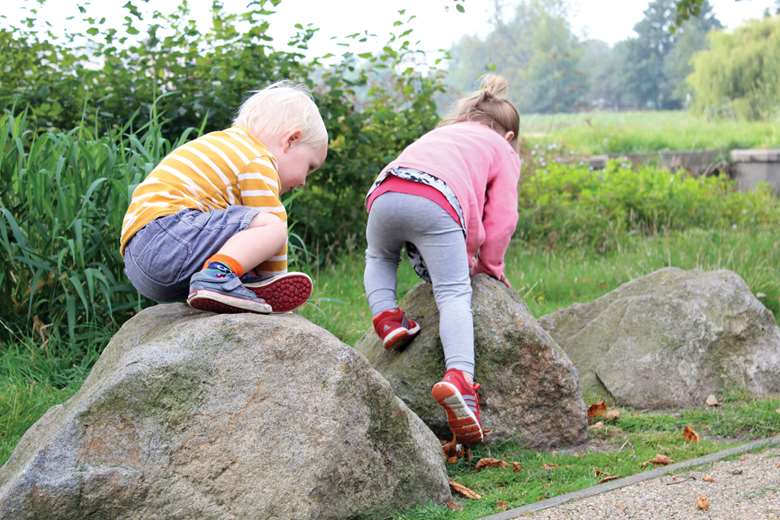Play Worth Remembering: Are Playgrounds Too Safe?
Derren Hayes
Wednesday, May 31, 2017
This study aimed to gauge the quality of today's playgrounds in comparison to the play spaces that survey respondents favoured as children.

- Authors: S Brunelle, S Herrington, R Coghlan, M Brussoni
- Children, Youth and Environments, (September 2016)
When asked to describe their favourite childhood place, most adults remember playing outdoors in natural settings such as the woods (Sandberg, 2003; Sebba, 1991). Research has demonstrated that children prefer natural over constructed play environments. However, typical contemporary playgrounds - containing pre-fabricated play equipment, a carpet of rubber safety surfacing, and a fence - do not resemble the natural play spaces that adults recall and children prefer.
Using memory as a perspective in understanding the value of play environments, the Play Worth Remembering study aimed to gauge the quality of today's playgrounds in comparison to the play spaces that survey respondents favoured as children. Using an online survey of adults (592 responses, 87 per cent from the US), the study aimed to understand the defining characteristics of favourite outdoor play spaces and determine how these environments support play, as well as to understand attitudes regarding contemporary play spaces, particularly concerning approaches to safety in design.
Perspectives on safety of contemporary playgrounds
A total of 69 per cent of respondents said today's playgrounds are too safe. Narrative responses on why this is revealed three major themes:
- They offer limited play opportunities (45.3 per cent)
- They offer not enough challenge (31.7 per cent)
- Safety-obsessed culture (18.9 per cent).
Limited play opportunities
Many respondents said safety was prioritised over healthy child development. Safety, here, refers to a situation where an outdoor play space is designed to protect children from danger, risk, or injury. A safe play space is one where risks of injury are low and manageable.
Not enough challenge
Challenge in a playground presents children with an activity that calls for great mental or physical effort and therefore tests capabilities. Challenge differs from the use of the word "risk" in the context of risky play, which is defined as thrilling and exciting play that can include the possibility of physical injury (Sandseter & Kennair, 2011). Types of risky play include play at height, speed, near dangerous elements (such as water, fire), with dangerous tools, rough play, and where there is the potential for disappearing or getting lost.
Safety-obsessed culture
Some respondents blamed "liability paranoia" and "over-protective parenting" for creating overly safe playgrounds. Respondents said these limit children's access to play outdoors.
Memorable play spaces are natural ones
The play spaces participants remembered as their childhood "favourite" contrasted substantially with today's model - 59 per cent preferred natural places compared with 14 per cent preferring spaces designed specifically for play, such as schoolyards and playgrounds. Forests and woods were by far the most popular play spaces (38 per cent).
Overwhelmingly "natural" elements such as sticks, logs, vegetation, rocks, boulders, and trees were the most popular features. The four least-selected elements - asphalt, gravel, fences, and play equipment - are those most commonly found in today's playgrounds.
Respondents said playing outdoors helped them develop life skills: "I believe that I learned how to overcome fears and challenge myself to complete tasks that seemed too dangerous."
They also helped build a sense of self, and overcome challenges: "I learned to trust my own judgment. I tested my mental and physical boundaries. I gained confidence and maturity. I learned how to take care of myself."

Qualities of play spaces
Most respondents (91 per cent) considered their play space safe and 88 per cent would allow their children to play in their childhood play space today. Overall, respondents were most likely to allow their children to play in their favourite play space because they found the experience beneficial (57 per cent).
Landscape qualities that respondents frequently described included:
- A flexible and open-ended space that can be modified, and adapted to suit children's imagination.
- A play space with a series of spaces that can be explored.
- A changing and changeable space that provides objects for play and discovery.
- A play space that offers a variety of physical challenges.
- A play space that connects children to nature.
Respondents described play environments that allowed them to connect with, explore and understand the natural world.
Implications for practice
Studies have established a correlation between the quality of a play environment and an increase in children's active play and motor development (Fjørtoft & Sageie, 2000). Conversely, studies have also determined that playgrounds that lack adequate space, challenge, and natural materials have a negative impact on their young users (Herrington, Lesmeister, 2006).
The authors conclude that professionals dealing with the built environment can make a significant contribution to children's outdoor play experiences through allowing and accommodating children's access to the landscape for play. Such an approach demands consideration of play on a neighbourhood scale, they say.
Offering children accessible child-friendly landscapes that have high play value can promote children's right to the landscape and create an environment that inspires rather than hinders play.
FURTHER READING
An Evaluation of Meriden Adventure Playground: Focus on Impact on Physical Activity and Healthy Eating, Nikita Price, Alison Trout, Journal of Playwork Practice, May 2017
Practice-based Research in Children's Play, edited by Wendy Russell, Stuart Lester, Hilary Smith, Policy Press, April 2017
Are Secondary School Environments Conducive for Active Play Opportunities? Brendon Hyndman, Barbara Chancellor, International Journal of Play, February 2017




